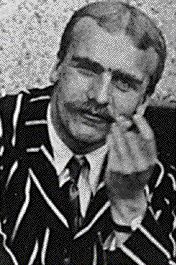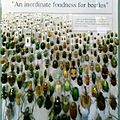J.B.S. Haldane facts for kids
Quick facts for kids
J. B. S. Haldane
|
|
|---|---|

Haldane in 1914
|
|
| Born | 5 November 1892 Oxford, England
|
| Died | 1 December 1964 (aged 72) Bhubaneswar, India
|
| Citizenship |
|
| Education | Eton College |
| Alma mater | New College, Oxford |
| Known for |
|
| Spouse(s) |
|
| Awards |
|
| Scientific career | |
| Fields | |
| Institutions |
|
| Academic advisors | Frederick Gowland Hopkins |
| Doctoral students |
|
| Military career | |
| Service/ |
British Army |
| Years of service | 1914–1920 |
| Rank | Captain |
| Battles/wars | First World War |
John Burdon Sanderson Haldane (November 5, 1892 – December 1, 1964) was a very smart scientist. He was born in Britain and later became an Indian citizen. He studied many things, like how living things work (physiology), how traits are passed down (genetics), and how species change over time (evolutionary biology). He also used math to study biology, especially in statistics.
Haldane's father, John Scott Haldane, was also a famous scientist. J.B.S. Haldane believed in socialism, which means he thought society should be more equal. He also followed ideas from Karl Marx about society and the economy. He was an atheist, meaning he didn't believe in God, and a humanist, focusing on human values. Because of his strong political views, he left England in 1956 and moved to India. He became an Indian citizen in 1961.
In 1915, Haldane showed how some genes are linked together in mammals. Later, his work helped create the field of population genetics. This field studies how genes change in groups of living things over time. He helped combine Mendel's ideas about how traits are inherited with natural selection, which is how species evolve. This was a big step in understanding evolution.
In 1929, he wrote about how life might have started. He introduced the "primordial soup theory." This idea suggested that early Earth had a mix of chemicals that could have led to the first life forms. Haldane also mapped human genes for conditions like haemophilia and color blindness on the X chromosome. He also came up with Haldane's rule about how some hybrid animals cannot have babies.
He correctly guessed that people with sickle-cell disease might be more resistant to malaria. He was also the first to suggest the main idea behind in vitro fertilisation (IVF), which helps people have babies. He even thought of ideas like the hydrogen economy and cloning organisms.
Contents
Haldane's Early Life and Military Service
Haldane's education was paused because of the First World War. He joined the British Army in 1914. He became a temporary second lieutenant and quickly rose to temporary captain. He fought in France and Iraq, where he was injured.
His commander called him "the bravest and dirtiest officer in my Army." This shows how fierce and determined he was in battle. He left the army in 1920 but kept his rank of captain.
Haldane's Academic Journey
After the war, from 1919 to 1922, Haldane was a Fellow at New College, Oxford University. Then, he moved to Cambridge University. There, he became a lecturer in Biochemistry at Trinity College and taught until 1932.
During his nine years at Cambridge, Haldane studied enzymes and genetics. He was especially good at using math in genetics. He also wrote many popular science essays. These essays were collected and published in 1927 in a book called Possible Worlds.
Later, he became a Professor of Genetics at University College London. He spent most of his career there. Four years later, he became the first Weldon Professor of Biometry at the same university. Biometry is about using statistics in biology.
Why Haldane Moved to India
Haldane's decision to move to India was for several reasons. He went to the Indian Statistical Institute (ISI). He was very interested in biological research, and he believed the warm climate would be good for his health. He also felt that India offered him more freedom and shared his socialist beliefs.
At the ISI, he led the biometry unit. He spent his time researching many different topics. He also guided other scientists around him.
Haldane's Final Years
Before he passed away from cancer, Haldane wrote a funny poem while in the hospital. The poem made fun of his own illness. His friends read it and liked how he kept his sense of humor, even at the end of his life. The poem was first printed in the New Statesman magazine in 1964.
He wanted his body to be used for medical studies after his death. He believed he could still be useful even then. The famous writer Arthur C. Clarke said Haldane was "perhaps the most brilliant science populariser of his generation." This means he was amazing at explaining science to everyone. Nobel winner Peter Medawar called Haldane "the cleverest man I ever knew."
Awards and Recognitions
Haldane received many awards and honors for his important work.
- In 1932, he was chosen as a Fellow of the Royal Society, a very respected group of scientists.
- The French Government gave him the Legion of Honour in 1937. This is a very high award in France.
- He received the Darwin Medal from the Royal Society in 1952.
- In 1956, he was given the Huxley Memorial Medal.
- He won the Feltrinelli Prize in 1961.
- He also received an Honorary Doctorate of Science and an Honorary Fellowship at New College, Oxford.
- He was given the Kimber Award from the US National Academy of Sciences.
- In 1958, he received the important Darwin–Wallace Medal from the Linnean Society of London.
Images for kids
-
J. B. S. Haldane Avenue in Kolkata, a busy road near Science City
-
Oxford University Museum of Natural History display dedicated to Haldane and his famous reply when asked about the Creator.
See also
 In Spanish: John Burdon Sanderson Haldane para niños
In Spanish: John Burdon Sanderson Haldane para niños




